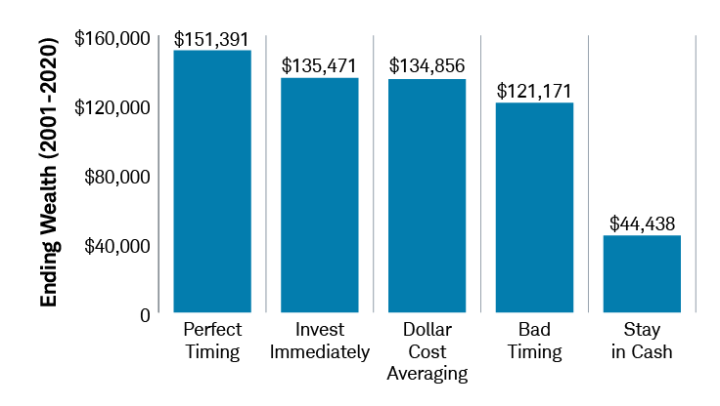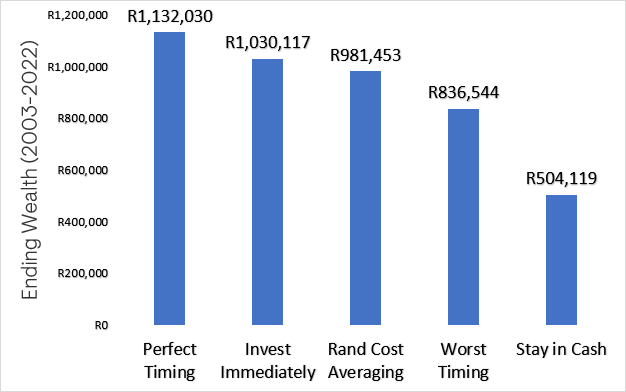SPONSORED CONTENT
Why bad timing trumps inertia when investing in equities

The timing of when, or even if, to invest in equities often seems fraught with danger – the markets are expensive, there is risk of a recession, interest rates are on the rise, countries are at war. You get the picture. Unfortunately, it seems that there is always something to be concerned about, and yet equity markets go up over time. And then, how best should you enter equity markets? Immediately? Gradually over time? Wait for the best possible entry point, but can you identify it, or for that matter avoid the worst entry point? One approach may be psychologically more comforting, however another may be statistically more sound. How do you determine the best way forward?
A recent study of the South African equity market confirmed that three quarters of the time it is better to invest a lump sum immediately, rather than rand-cost average in over 12 months. These results were almost identical to a similar study of the S&P500, which found that 75% of the time it is also better to invest a lump sum immediately into the US equity market, rather than dollar-cost average in over 12 months.
But what is the opportunity cost of investing immediately, compared to timing the market perfectly (accepting that this is impossible)? And, how does the overall outcome compare to the worst possible timing, or not investing at all and therefore staying in cash?
In this vein, an advisor partner of ours forwarded the results of a fascinating Schwab Center for Financial Research study, which concluded that “There’s a high cost to waiting for the best entry point.” Schwab analysed the results of five different long-term investors, following quite different implementation strategies. The five implementation strategies were:
- Perfect timing by investing at the lowest point in each calendar year.
- Invest immediately on the first day of each calendar year.
- Dollar cost averaging in at the beginning of each month.
- Worst timing by investing at the highest point in each calendar year.
- Staying in cash.
In the study, each investor received $2 000 at the beginning of every year for the 20 years from beginning 2001 to the end of 2020. The results are shown in the following bar graph, where the dollar value is the amount each investor had accumulated after 20 years. And naturally, ‘Perfect timing’ produces the best outcome, but this is not a realistic strategy. What is particularly interesting though is how close the ‘Invest immediately’ strategy comes to ‘Perfect timing’, reinforcing the importance of getting and staying invested, and benefiting from compounding returns. A further important outcome is that even the ‘Worst timing’ strategy materially outperformed ‘Staying in cash’.
Figure 1: Even bad timing trumps inertia

Source: Schwab Center for Financial Research. Invested $2 000 annually in a hypothetical portfolio that tracks the S&P500 Index from 2001 – 2020
For completeness, Schwab replicated this study over multiple 20-year periods, with remarkably similar outcomes to those described above.
So, what of the South African equity market?
We used FTSE/JSE All Share Index (ALSI) return data from January 2003 to December 2022 and replicated the Schwab study by comparing the outcome of the above five strategies. As expected, the results, which are shown in the following graph, are uncannily similar for the SA equity market; the ‘Perfect timing’ strategy outperformed ‘Invest immediately’, which outperformed ‘rand-cost average in’, which outperformed ‘Worst timing’, all of which materially outperform ‘Staying in cash’. The ‘Invest immediately’ strategy generated an annualised return of 12.5% per annum over the 20-year period, almost 6% per annum ahead of the 6.6% per annum annualised return delivered by ‘Staying in cash’.
Figure 2: Invest immediately and stay the course

Source: Morningstar and Ninety One calculations
So, if you are in the fortunate position of deciding when to make a long term lump sum investment (such as investing a discretionary bonus, making a retirement annuity top-up, or annual TFSA contribution) into the equity market, the results suggest doing so immediately. Accept that market timing is almost impossible, so having determined (with the help of a financial advisor) your appropriate level of exposure to equities based on your financial goals and risk tolerance, invest immediately.
How best then to access the equity market? The Ninety One Equity Fund
The Ninety One Equity Fund is an actively managed portfolio of domestic and offshore listed equities with an enviable long-term track record.Built around a robust and repeatable investment process, the Fund aims to deliver long-term capital growth. Its unique investment philosophy is focused on investing in companies where expected future profits are being revised upwards and where the companies are trading at reasonable valuations. DM/BM
Author: Paul Hutchinson, Sales Manager at Ninety One.

















 Become an Insider
Become an Insider